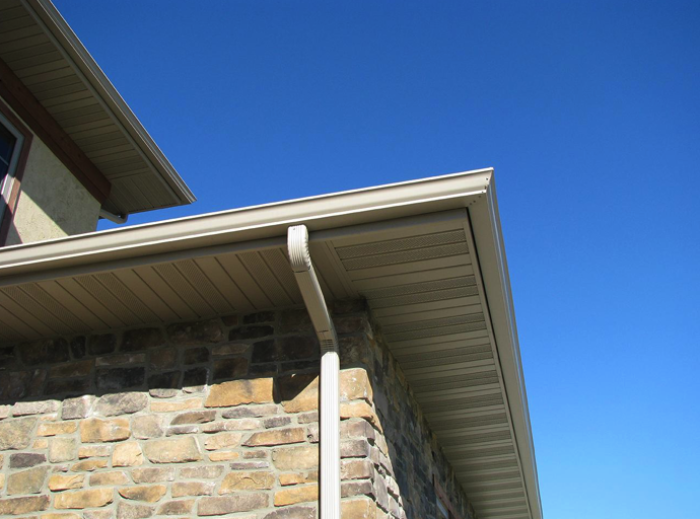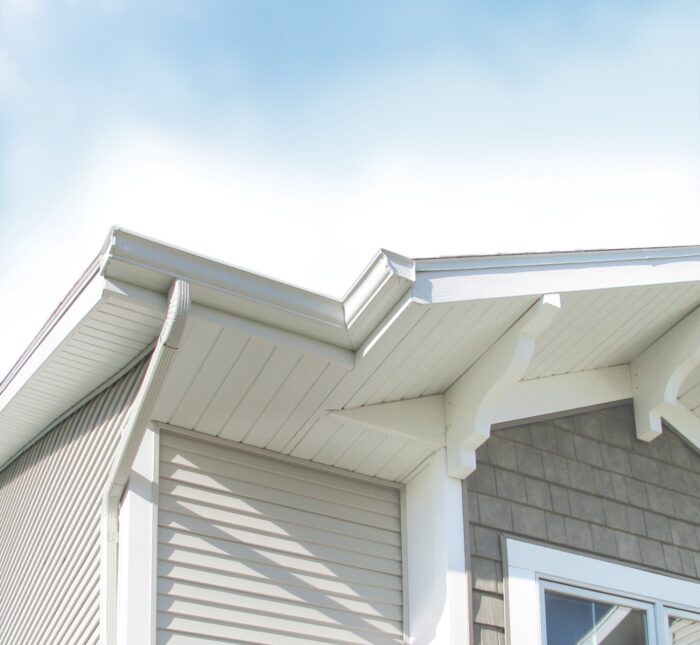Whether you are building a new home or renovating your current one, it’s important to pay attention to every detail, including the material you use for your soffit. This seemingly small detail on the exterior of your home can actually make a big difference in air circulation and moisture protection.
Knowing what soffit is and whether wood or aluminum soffit is best for your needs is key to protecting your home. Take a few minutes to get familiar with soffit and the advantages and disadvantages of both wood soffit and aluminum soffit.
What is Soffit and Why is it Important?

Soffit is the covering on the underside of your roofline. It’s what protects the bare beams that connect your roof overhang to the sides of your house, and it is vital to the defense of your attic and rafters.
Soffit protects your eaves and attic space from the elements. If the rafters themselves are exposed to rain and moisture, it can lead to mold problems. This, in turn, can cause your rafters to rot and lead to dangerous or costly consequences.
Soffit can be either solid or vented. When replacing your soffit, make sure to choose vented soffit. Without vented soffit, the lack of ventilation in your attic could lead to moisture buildup, ice dams, higher cooling costs in summer and a shorter lifespan for your roof’s shingles.
Your home can also “breathe” better when you have vented soffit applied. It allows air to circulate in the roof and attic areas, allowing your home to have proper circulation.
(Still have questions about Soffit? Get more answers here: What are Soffits and Why do They Matter.)
Aluminum Soffit vs. Wood Soffit: Which is Best?
When choosing soffit for your home, it’s important to consider the best material option for you. While there are several types of soffit, the two main types are wood and aluminum. Each comes with its own advantages and disadvantages.
Wood Soffit
Wood soffit is a popular choice among builders and homeowners. However, wood soffit can also be very high-maintenance. It is prone to rot when exposed to the elements, resulting in costly repairs or replacement. It’s also susceptible to insect infestation.
Wood soffit has to be scraped, treated or stained every few years to help protect it from weathering and to keep it looking its best. Wood tends to be quite expensive, as well, both in the original purchase and in maintenance costs.
Aluminum Soffit

Aluminum soffit is a less traditional choice but has many advantages. It is very low-maintenance compared to wood. It doesn’t require painting or staining, and it only needs occasional, easy cleaning with your garden hose. This low-maintenance means you can stay inside to watch the game instead of lugging tall ladders around your house to scrap and paint the soffit.
Aluminum soffit is also available in a wide variety of colors that can fit any home design or style. It also works well with all exterior types, including brick, stucco, steel siding and more.
Aluminum offers better damage protection compared to wood, as well. It won’t rot and is resistant to bugs. Plus, it’s better at resisting moisture, which protects your rafters and attic from rot and other damage. Many roofing shingle companies require homes to have their attic spaces properly vented to comply with their warranty, which vented aluminum soffit can when used as a part of a balanced system.
Properly vented spaces can also prevent ice dams from forming on your roofline and improve air quality.
Choosing the Right Soffit for You
It’s important to consider the advantages and disadvantages of wood and aluminum when choosing soffit for your home. Wood may provide a more natural look, but vented aluminum soffit provides moisture protection, easy maintenance and improved air quality, thanks to its ability to properly ventilate the attic. Choose the soffit that will provide your home with the greatest security and protection from damage.
To learn more about using aluminum soffit on your home, contact Rollex, the industry leader in exterior home products.




